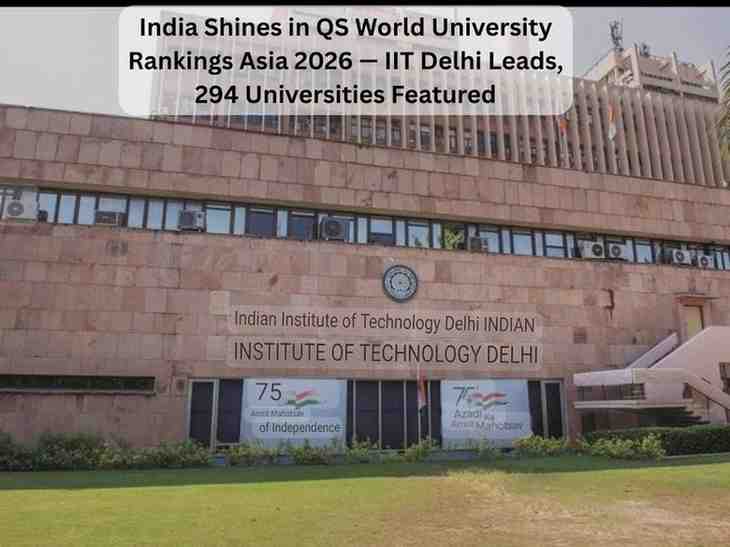India’s Higher Education on a Global Ascent: QS World University Rankings Asia 2026 Highlight a Decade of Unprecedented Growth

India’s higher education system has reached a defining moment. According to the QS World University Rankings: Asia 2026, India has achieved a remarkable milestone — featuring 294 universities, compared to just 24 institutions in 2016. This exponential twelvefold growth over a decade marks a sweeping transformation in the nation’s academic landscape, cementing India’s rise as one of Asia’s leading education powerhouses.
With this performance, India has now emerged as Asia’s second-largest contributor to the QS rankings, standing next only to China, which leads the region with 395 institutions. Beyond sheer numbers, this achievement reflects how Indian universities have expanded their global competitiveness, improved their academic quality, and enhanced their research output — signalling a decisive move toward becoming a hub for innovation-driven learning in Asia.
IITs and IISc Continue to Lead India’s Charge
The Indian Institutes of Technology (IITs) remain at the forefront of India’s higher education success story. Among them, IIT Delhi shines brightest, securing the 59th position in Asia and maintaining its distinction as India’s top-ranked institution for the fifth year in a row.
Other IITs — including IIT Bombay, IIT Madras, IIT Kanpur, and IIT Kharagpur — also feature prominently among the continent’s top 100, alongside the Indian Institute of Science (IISc) Bengaluru and Delhi University (DU). These institutions are recognized not only for their strong research performance and academic excellence but also for fostering global collaborations and cutting-edge innovation.
This year’s rankings bring another encouraging development: 36 Indian universities have improved their positions, reflecting a broader culture of progress across the system. Among the most notable climbers is Sathyabama Institute of Science and Technology, which soared 111 places to reach the 262nd rank — a testament to the dynamism and rising quality of Indian higher education.
India’s Research Prowess: Rising Through the Ranks
A standout strength for India in the QS Asia 2026 rankings is its exceptional showing in the “Papers per Faculty” indicator — one of the most critical metrics assessing research productivity.
In this category:
- Five Indian universities rank among Asia’s top 10
- Twenty-eight appear in the top 50
This surge showcases India’s growing commitment to research-led education. Faculty members across both premier and regional universities are increasingly contributing to global academic publications, tackling real-world challenges, and driving innovation that aligns with the nation’s developmental goals. The consistent improvement in research quality reflects a deeper institutional transformation — one that blends curiosity, technology, and societal impact.
Government Policy: The Engine of India’s Academic Transformation
India’s climb in global education rankings did not happen by chance. It is the result of sustained government policy reforms, strategic funding, and institutional empowerment designed to modernize and globalize the country’s higher education sector.
1. Boosting Funding and Institutional Autonomy
Programs like the Institutions of Eminence (IoE) scheme provide up to ₹1,000 crore over five years to select public universities. This initiative gives top-performing institutions financial independence to upgrade research infrastructure, hire world-class faculty, and expand global partnerships.
2. Graded Autonomy for Excellence
The University Grants Commission (UGC) introduced a graded autonomy framework in 2018, allowing universities with strong performance records to design new courses, collaborate internationally, and make administrative decisions independently — fostering agility and innovation.
3. Building a Research-Oriented Ecosystem
The establishment of the National Research Foundation (NRF), with a proposed five-year outlay of ₹50,000 crore, aims to connect academia, industry, and international research partners. This national body is set to transform India’s research environment, promoting interdisciplinary work and encouraging young scholars to pursue impactful research.
4. Faculty Training and Quality Improvement
To improve teaching and research outcomes, the government launched Faculty Development Centres (FDCs) and Faculty Recharge Initiatives. These programs emphasize academic training, mentoring, and research exposure, ensuring that educators stay aligned with global best practices.
5. Promoting Global Engagement
Initiatives such as Study in India, GIAN (Global Initiative of Academic Networks), and new bilateral academic partnerships have enhanced India’s international visibility. By encouraging foreign students and collaborations, these programs strengthen India’s international research network — an important metric in global rankings.
6. Infrastructure and Modernization
Through the Higher Education Financing Agency (HEFA), massive investments have been made to modernize infrastructure — from advanced research labs and libraries to smart classrooms and digital learning environments. This has bridged crucial gaps in educational access and quality.
7. Quality Assurance and Accreditation Reforms
Reforms by the National Assessment and Accreditation Council (NAAC) have brought India’s accreditation standards closer to international benchmarks. The process encourages institutions to maintain excellence in curriculum design, teaching outcomes, and research performance.
National Education Policy (NEP) 2020: The Vision Blueprint
The National Education Policy (NEP) 2020 is arguably the cornerstone of India’s education reform movement. It reimagines learning as multidisciplinary, inclusive, and flexible, encouraging creativity, critical thinking, and innovation.
The NEP’s goals are ambitious — targeting a 50% Gross Enrollment Ratio (GER) in higher education by 2035, and promoting global competitiveness through academic freedom and research-driven curricula. Since its implementation, universities have started adopting credit-based systems, interdisciplinary courses, and skill-oriented programs, marking a visible shift in academic quality.
Transformative Schemes Shaping the Future
Institutions of Eminence (IoE)
Launched in 2017, the IoE scheme identifies and empowers select universities to evolve into world-class global institutions with greater funding and autonomy, enhancing India’s global visibility in education.
Rashtriya Uchchatar Shiksha Abhiyan (RUSA)
Introduced in 2013, RUSA focuses on improving state universities — enhancing equity, access, and quality across India’s diverse higher education landscape. By bridging the gap between central and regional institutions, it ensures inclusive academic growth.
SWAYAM: Democratizing Digital Learning
The SWAYAM initiative has revolutionized access to education by providing free online courses (MOOCs) developed by India’s top universities. It supports continuous learning and upskilling for millions of students and professionals nationwide, blending accessibility with quality education.
India’s Homegrown Quality Frameworks
To sustain quality and accountability, India has developed its own benchmarking tools that complement international rankings.
National Institutional Ranking Framework (NIRF)
Launched in 2015, NIRF ranks institutions based on teaching, research, graduation outcomes, outreach, and perception. This annual exercise promotes a culture of self-assessment and continuous improvement, motivating institutions to perform better each year.
All India Survey on Higher Education (AISHE)
Since 2010-11, AISHE has provided crucial data on enrollment, faculty, and infrastructure, guiding policymakers to identify trends, gaps, and development needs. This has made resource allocation more evidence-based and outcome-driven.
Conclusion: India’s Academic Renaissance
The QS World University Rankings: Asia 2026 mark a defining chapter in India’s academic journey. From 24 ranked universities in 2016 to 294 in 2026, the trajectory is not just impressive — it’s transformational.
With seven Indian universities now among Asia’s top 100, led by IIT Delhi, the data reflects how sustained reforms, innovation, and global collaboration have reshaped India’s educational identity.
As India continues to prioritize research, autonomy, and international partnerships, the path ahead points toward an era where Indian universities won’t just feature prominently in Asia — they will compete among the world’s finest institutions.
The past decade was about building the foundation. The next one will be about achieving global excellence.
India’s higher education system is no longer catching up — it’s leading from the front, vibrant and future-ready, poised to shape the knowledge economy of tomorrow.
Quick Facts: QS Asia University Rankings 2026
📘 Indian institutions in Asia’s Top 100: 7
🏛️ Highest-ranked Indian university: IIT Delhi (59th)
📈 Total Indian universities featured: 294
🌏 India’s overall representation rank: 2nd (after China)
🎯 Target Gross Enrollment Ratio by 2035: 50%



